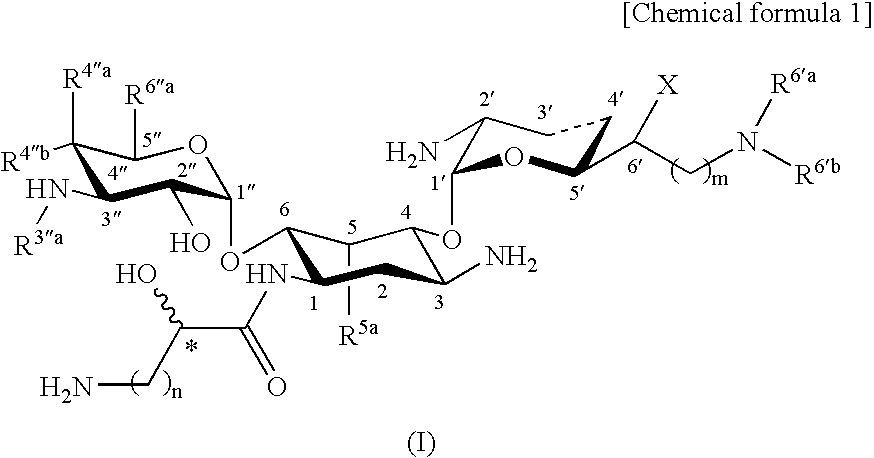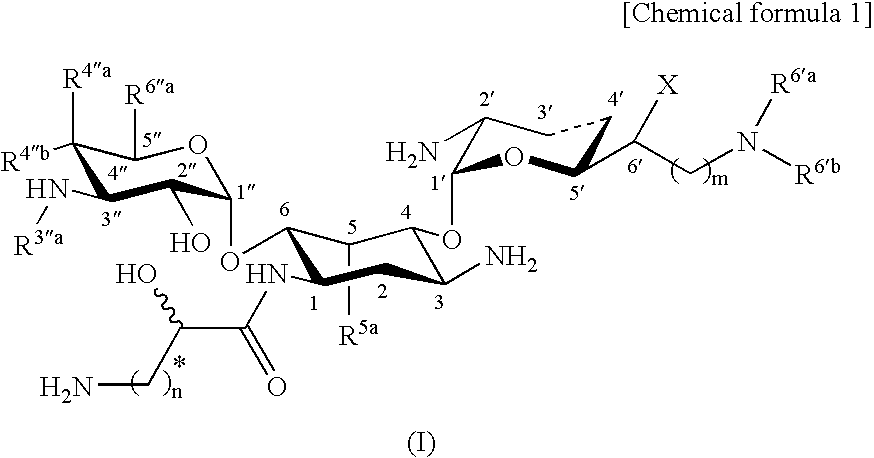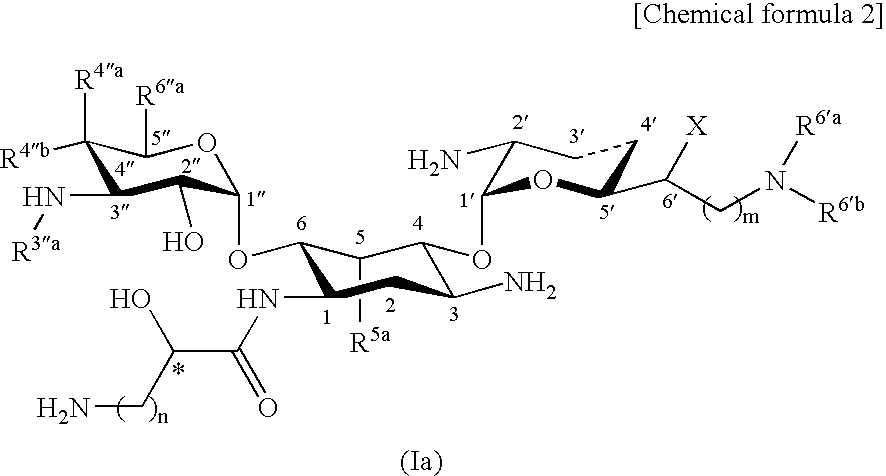Novel aminoglycoside antibiotics effective against methicillin resistant staphylococcus auerus (mrsas)
a technology of aminoglycosides and antibiotics, which is applied in the direction of antibiotics, antibacterial agents, drug compositions, etc., can solve the problems of not revealing the anti-mrsa activity of 5-epi derivatives, and achieve excellent antimicrobial activity and significant antimicrobial activity
- Summary
- Abstract
- Description
- Claims
- Application Information
AI Technical Summary
Benefits of technology
Problems solved by technology
Method used
Image
Examples
example 1
5.4″-Diepiarbekacin
[0589]
Production Step 1-(a)
[0590] N,N-Dimethylformamide (900 mL) was added to a solution of 100 g of arbekacin dissolved in 450 mL of water. Di-t-butyl dicarbonate (250 g) was added thereto under an ice bath, and the mixture was stirred at room temperature overnight. Ethyl acetate was added to the reaction solution, and the mixture was washed with a saturated aqueous sodium hydrogencarbonate solution and a saturated aqueous sodium chloride solution in that order and was dried over anhydrous magnesium sulfate. This solution was concentrated to dryness to give 188 g of the following compound as a solid.
Production Step 1-(b)
[0591] The compound (40 g) prepared in production step 1-(a) was dissolved in 360 mL of N,N-dimethylformamide, 11.6 mL of 1,1-dimethoxycyclohexane and 1.3 g of p-toluenesulfonic acid monohydrate were added to the solution, and the mixture was allowed to react under conditions of 50° C. and 46 to 48 mbar for 5 hr. Ethyl acetate was added the...
example 2
5-Deoxy-4″-epi-5-epifluoroarbekacin
[0604]
Production Step 2-(a)
[0605] The compound (2.5 g) prepared in production step 1-(b) of Example 1 was dissolved in 7.0 mL of pyridine, 3.0 mL of acetic anhydride was added to the solution, and the mixture was stirred at room temperature overnight. The reaction solution was extracted with ethyl acetate, dried over anhydrous magnesium sulfate, and was then concentrated under the reduced pressure. The residue was purified by column chromatography on silica gel (hexane:ethyl acetate=1:2) to give 1.9 g of the following compound.
[0606] ESIMS: m / z 1217 [M+H]+.
Production Step 2-(b)
[0607] 1.0 g of the compound prepared in production step 2-(a) was used in the same manner as in production step 1-(f) in Example 1 to give the following compound (0.91 g).
[0608] FABMS: m / z 1159 [M+Na]+
Production Step 2-(c)
[0609] 2.4 g of the compound prepared in production step 2-(b) was used in the same manner as in production step 1-(g) to give the following co...
example 3
5-Deoxy-4″-epi-5-epichloroarbekacin
[0616]
Production Step 3-(a)
[0617] 0.28 g of the compound prepared in production step 2-(d) was used in the same manner as in production step 1-(d) to give the following compound (0.21 g).
Production Step 3-(b)
[0618] 0.21 g of the compound prepared in production step 3-(a) was used in the same manner as in production step 1-(e) in Example 1 except that lithium chloride was used instead of cesium acetate, to give the following compound (0.13 g).
[0619] FABMS: m / z 1461 [M+Na]+, 1477 [M+K]+.
Production Step 3-(c)
[0620] 130 mg of the compound prepared in production step 3-(b) was used in the same manner as in production steps 1-(i) and 1-(j) to give the title compound: 5-deoxy-4″-epi-5-epichloroarbekacin (14.0 mg)
[0621] FABMS: m / z 571 [M+H]+1H-NMR (D2O+ND3) δ: 1.60 (2H, m), 1.92 (4H, m), 2.11 (1H, m), 2.26 (1H, m), 2.85 (2H, m), 2.98 (3H, m), 3.16 (1H, dd, J=2.9, 10.7 Hz), 3.52 (1H, m), 3.77 (1H, dd, J=3.9, 10.7 Hz), 3.92 (3H, m), 4.02 (1H, m)...
PUM
| Property | Measurement | Unit |
|---|---|---|
| temperature | aaaaa | aaaaa |
| temperature | aaaaa | aaaaa |
| temperature | aaaaa | aaaaa |
Abstract
Description
Claims
Application Information
 Login to View More
Login to View More - R&D
- Intellectual Property
- Life Sciences
- Materials
- Tech Scout
- Unparalleled Data Quality
- Higher Quality Content
- 60% Fewer Hallucinations
Browse by: Latest US Patents, China's latest patents, Technical Efficacy Thesaurus, Application Domain, Technology Topic, Popular Technical Reports.
© 2025 PatSnap. All rights reserved.Legal|Privacy policy|Modern Slavery Act Transparency Statement|Sitemap|About US| Contact US: help@patsnap.com



